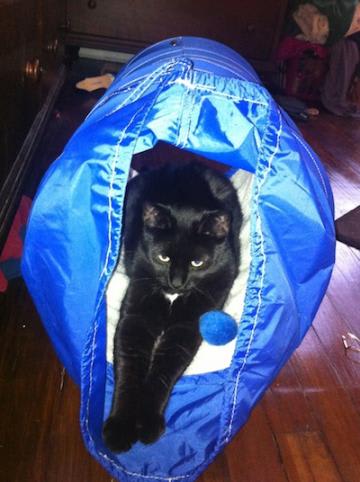
Sometimes a few symptoms that make your pet seem "off" or 'under the weather" can actually be signs of something bigger. Smitty's mom's observations and quick actions helped save Smitty's life. Smitty could not urinate, he was "blocked". Learn about this medical emergency, symptoms, and what treatment is needed to increase the chance of recovery.
Author: Amy Plankhorn, DVM
Smitty is a gorgeous big black kitty who was adopted in 2010. He has a great life hanging out in his apartment with family. But one day his mom saw that Smitty wasn’t feeling well. He was withdrawn, depressed, and vomiting. She called Animal Hospital of North Asheville and got him right in to the hospital. When Smitty arrived, he was immediately examined by Dr. Amy Plankenhorn. His body temperature was low, he was dehydrated, and most importantly, his abdomen was very painful. It felt like his bladder was extremely enlarged, hard, and painful. An ultrasound examination of his bladder confirmed that it was very full, consistent with an obstruction in his urethra (the tube that carries urine out of the bladder), and that he did not have any stones in his bladder.
At Dr. Plankenhorn’s direction, our certified veterinary technicians immediately placed an intravenous catheter for IV fluids and began warming him using a Bair hugger warming blanket and micro-bags. He was given a narcotic to sedate him slightly and to treat pain, then put under emergency anesthesia. Blood tests were obtained and run in our in-house lab to assess his kidney values and his sodium, potassium, and chloride levels. Dr. Plankenhorn then carefully passed a small urinary catheter coated with a numbing lubricant gel into his urethra. The catheter did not pass easily, but with gentle flushing with saline solution and patience, she was able to relieve the blockage and get the catheter into the bladder. Once the catheter was in the bladder, urine could be removed easily.
What causes urinary obstructions?
There are several reasons that cats develop urinary obstruction. In cats under 10 years old, the most common cause is a urethral “plug,” which is typically a combination of crystals that have formed in the urine and mucous that the body makes as a response to the irritation. The crystals and the mucous join together to create a dam effect in the urethra. While female cats can develop crystals and bladder irritation, their urethra is usually wide enough to keep them from getting obstructed with plugs. Male cats have a very small urethra, so even a small amount of the crystals and mucous can start a blockage. The other cause of urinary obstruction in cats, especially those over 10 years old, is the presence of bladder stones. Very small stones can pass into the urethra and become lodged, causing blockage. Again, males are more susceptible to blockage, although male and female cats can develop stones. Stones in the bladder can be seen with ultrasound, but the tiny stones in the urethra may require detailed x-rays to find. Our digital radiography system allows us to see very fine detail, even when the picture is zoomed in.

What are the complications or symptoms of obstructions or buildup of urine in the bladder?
If an animal is unable to urinate, there are many complications that can occur due to the buildup of urine in the bladder. The most obvious problem is pain which occurs in the bladder as the bladder wall becomes overly stretched and in the urethra from the blockage material and frequent straining. If an obstruction is present for 24 hours, toxins start to build up in the bloodstream. Potassium levels increase, causing potentially fatal heart rhythm abnormalities. Other waste products excreted by the kidneys also build up, causing vomiting and lethargy. If enough time elapses, the kidneys can even become damaged. The bladder muscles can become overly stretched, causing the bladder to lose tone and become unable to empty. And the urethra becomes swollen and inflamed, causing spasms and straining even after the obstruction is relieved.
The typical first signs of urinary obstruction in cats include frequent attempts to urinate, lengthy attempts to urinate, licking the genitals frequently, hiding, and abdominal discomfort. Obstructed cats will often spend a lot of time in the litter pan with nothing produced, or will even attempt to urinate in other locations besides their pan. This is the best time to intervene! The challenge is that cats can have cystitis (inflammation in the bladder) that looks very similar to urinary obstruction but is not as dangerous. If you are in doubt, we’d rather check the bladder and determine that your cat does not have a blockage rather than waiting until the problem is more severe and may become life threatening.

Unfortunately, Smitty didn’t show his mom the typical signs of obstruction. Cats have a natural instinct to hide signs of illness because if they were living in the wild, appearing ill would make them vulnerable to attack. As a result, Smitty was very sick when he arrived at the hospital. His kidney values and his potassium were elevated, although he didn’t have any heart abnormalities yet. Because he had been obstructed for enough time to make him sick, his urinary catheter was sewn into place and attached to a sterile tube and collection bag to allow his bladder to stay empty. He also received high doses of intravenous fluids to help remove the kidney toxins that had built up in his system. After a few days on IV fluids, his kidney tests were much better and his urine was no longer bloody. It was time to remove his urinary catheter to see if he could urinate on his own. Cats who have experienced a urinary obstruction are more prone to having another blockage, so we have to pay close attention to urine output in the days afterward and beyond. Smitty needed some medication to relieve urethral spasms, but was able to urinate normally within a few days. There are many factors that lead to urethral plugs in cats, some of which are not completely understood.
What can help cats who are proned to urinary concerns?
Many cats benefit from a special prescription diet designed to reduce the formation of crystals in the bladder. Increasing water consumption by feeding canned food and making sure there are plenty of water sources around the house is also beneficial. Stress also appears to be a major factor in causing bladder inflammation. Even a cat who has a very easy lifestyle can benefit from environmental enrichment and stress reducing measures. A great resource for more information on reducing stress in your cat’s life is the Indoor Cat Initiative: http://indoorpet.osu.edu/cats/
Smitty is at home and doing very well. His mom is watching his urination closely. He’s enjoying his canned food and the extra attention he’s getting!
Cats are great at hiding symptoms when they are not feeling well. If you have concerns that your feline friend is not acting like themselves, call us to schedule an appointment.
5/2013
